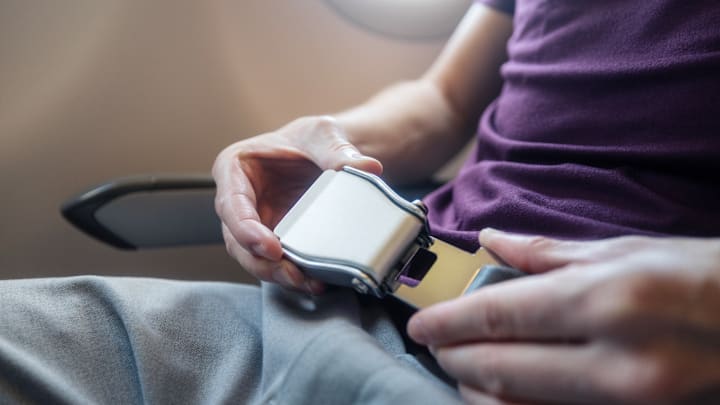Aviation safety is on many travelers’ minds after a string of crashes and in-flight mishaps dominated headlines in early 2025. While the general sense of unease is likely a result of the frequency illusion—statistics show that air travel is just as safe as it’s ever been—it’s always a good idea to practice safe habits while flying. And while you have little control over what happens in the skies, just one small change to your travel routines could give you better odds of a smooth landing.
Buckle up, folks. Literally.
How Common Is Turbulence?
While the odds of being involved in a plane crash are still extremely low, turbulence is a very real danger when you’re flying above 10,000 feet. According to the National Center for Atmospheric Research, pilots report 65,000 encounters with moderate turbulence and 5500 encounters with severe turbulence in the U.S. per year. Bumpy flights are sometimes unavoidable, but it is better your luggage gets tossed around than you.
“The basic truth is that an aircraft is a hard surface and people are soft,” Emma Henderson, a former airline captain, wrote for Business Insider. She echoed arguments from experts who maintain staying buckled in your seat for the duration of your flight is the best precaution travelers can take these days.
“Even if you're flying in very clear air with good visibility all around you, an aircraft might have crossed your path a couple of miles ago and you could fly through their wake and get a slight jolt,” Henderson explained. “Putting on a seatbelt means if anything should happen, you’re much less likely to become injured.”
What Makes Turbulence So Dangerous?
This issue became international news last year when severe turbulence struck a Singapore Airlines flight, resulting in the death of a passenger on board. While newer aircraft can often spot dangerous weather and even patches of rocky air space, their radar systems aren’t foolproof. Henderson was quick to point out how rare the event on Signapore Airlines was, but the tragedy is also the best argument for staying strapped in while you are in the air.
Severe turbulence isn’t a serious threat to the aircraft itself. The last time a commercial plane crash was attributed to turbulence was 1966. Even though the plane itself isn’t in danger when it hits rough air, everyone in the cabin still has to grapple with the effects of gravity, which is why seatbelts are so important. Those harsh drops can result in concussions, broken bones, and even fatalities when passengers aren’t securely seated.
“If you’re not seat belted, by definition, you’ll become a projectile, you’re a catapult, you will lift up out of your seat,” Paul Williams, a professor of atmospheric science at the University of Reading in England, told The New York Times in 2024.
So, unless you’ve pulled into your gate and the captain has given the all-clear—or you really need to use the bathroom when the seatbelt sign is off—stay safe, stay seated, and stay buckled.
Read More About Air Travel:
